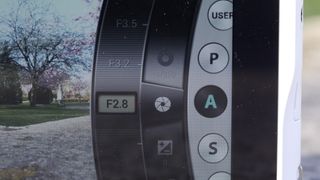Why you can trust TechRadar
The image quality of the Samsung Galaxy Camera 2 is far superior to what the average smartphone is capable of, so if you're just looking for a device that can take decent pictures and has smartphone functionality, then you should be pleased with the Galaxy Camera 2.
Overall, colours are bright and punchy straight from the camera. If you're not happy with the way colours look, you can try shooting in one of the different scene modes, such as landscape. There's not much control over colours when using the semi-automatic and manual control modes though.
Detail is acceptable, especially when looking at images at normal printing or web sizes – which we expect the majority of users of this camera will do. Occasionally, some images can have an overall look of softness.
Images taken at low sensitivities, such as ISO 200, display a good level of detail when looking at them at 100%, but as the sensitivity creeps up, to around ISO 800, a loss of detail becomes evident, even when viewing at normal printing sizes.

In certain areas of the image a painterly effect can be seen, which is especially problematic if you're photographing something with fine detail. As the sensitivity reaches its maximum setting of ISO 3200, even more detail is lost, so while this setting is good for very dark conditions – and it's certainly better than not being able to get the shot at all – if you want to view or print them at large sizes, shooting at high sensitivities isn't recommended.
Generally speaking, the Galaxy Camera 2's metering is very capable of producing well-exposed images without needing much interference from exposure compensation. If you point the lens towards the sun, likely you'll get some degree of lens flare, which is to be expected, but otherwise we weren't able to find any examples of flare or ghosting.
I found the automatic white balance system does a good job of producing accurate colours in daylight conditions, but if you use the camera under artificial light, it can struggle and you might need to switch to a more appropriate white balance setting, such as incandescent.

Focusing is quick, and usually accurate, especially in good light. As the light drops, the lens may hunt around for a little while, but it's not too bad, and a focus assist lamp helps when the light is very low. You can activate macro focusing from within the settings menu, which is helpful when you want to get close to a subject.
Using this setting allows the lens to be very close indeed to the subject, with the resulting images full of detail. Because the whole screen is available to select a focus point from, it's usually possible to identify one area of the subject that the lens can easily focus on for a sharp image.
Despite the relatively small sensor size (when compared to a compact system camera or DSLR), the Galaxy Camera 2 is still capable of producing some attractive shallow depth of field effects. Out of focus areas are rendered very nicely, with some very nice bokeh effects.

The 21x optical zoom lens is a good range to have a camera of this type, and is what sets it apart from a smartphone. Images taken at the far reach of the telephoto optic demonstrate a degree of softness and loss of detail when examined very closely at 100%, but the overall impression is pretty sharp, so if you're just planning to share images online, it should be fine.
It's not the best performance we've seen from a compact camera, which suggests the optics on the Samsung Galaxy Camera 2 are a bit of a compromise to satisfy those who crave the Android functionality over performance.
Current page: Performance
Prev Page Build quality and handling Next Page Image quality and resolutionAmy has been writing about cameras, photography and associated tech since 2009. Amy was once part of the photography testing team for Future Publishing working across TechRadar, Digital Camera, PhotoPlus, N Photo and Photography Week. For her photography, she has won awards and has been exhibited. She often partakes in unusual projects - including one intense year where she used a different camera every single day. Amy is currently the Features Editor at Amateur Photographer magazine, and in her increasingly little spare time works across a number of high-profile publications including Wired, Stuff, Digital Camera World, Expert Reviews, and just a little off-tangent, PetsRadar.


